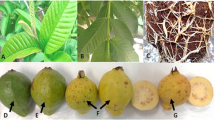Summary
Using the expression vector λgt11 and immunological detection, cDNA clones of an endopolygalacturonase gene of tomato (Lycopersicon esculentum Mill.) were isolated and sequenced. The 1.6 kb cDNA sequence predicts a single open reading frame encoding a polypeptide of 457 amino acids. The PG2A isoform of tomato fruit endopolygalacturonase was purified and 80% of the amino acid sequence determined. The amino acid sequence predicted by the cDNA sequence was identical to the amino acid sequence of the PG2A isoform. The position of the codon for the N-terminal amino acid of mature PG2A in the open reading frame indicates the presence of a 71 amino acid N-terminal signal peptide which is post-translationally processed. The C-terminus of purified PG2A occurred 13 amino acids before the stop codon in the cDNA suggesting that C-terminal processing of PG2A may also occur. The nucleotide and amino acid sequence data predict a mature protein of 373 amino acids and a polypeptide molecular weight of 40279. The sequence contains four potential glycosylation sites. Northern analysis detected endopolyga-lacturonase mRNA in stage 3 (turning) and stage 6 (red) ripening fruit, but not in leaves, roots, or green fruit of normal cultivars or in mature fruit of the rin mutant.
Similar content being viewed by others
References
Ali ZM, Brady CJ (1982) Purification and characterization of polygalacturonases of tomato fruits. Aust J Plant Physiol 9:155–169
Bennett AB, Christoffersen RE (1986) Synthesis and processing of cellulase from ripening avocado fruit. Plant Physiol 81:830–835
Biggs MS, Harriman RW, Handa AK (1986) Changes in gene expression during tomato fruit ripening. Plant Physiol 81:395–403
Chia CP, Arntzen CJ (1986) Evidence for two step processing of nuclear-encoded chloroplast proteins during membrane assembly. J Cell Biol 103:725–732
Christoffersen RE, Warm E, Laties GG (1982) Gene expression during fruit ripening in avocado. Planta 155:52–57
Christoffersen RE, Tucker ML, Laites GG (1984) Gene expression during fruit ripening in avocado fruit: the accumulation of cellulase mRNA and protein as demonstrated by cDNA hybridization and immunodetection. Plant Mol Biol 3:385–391
Colbert JT, Hershey HP, Quail P (1983) Autoregulatory control of translatable phytochrome mRNA levels. Proc Natl Acad Sci USA 80:2248–2252
DellaPenna D, Alexander DC, Bennett AB (1986) Molecular cloning of tomato fruit polygalacturonase — analysis of polygalacturonase mRNA levels during ripening. Proc Natl Acad Sci USA 83:6420–6424
Facciotti D, O'Neal JK, Lee S, Shewmaker CK (1985) Light inducible expression of a chimeric gene in soybean tissue transformed with Agrobacterium. Bio/Technology 3:241–246
Grierson D, Slater A, Speirs J, Tucker GA (1985) The appearance of polygalacturonase in tomatoes: one of a series of changes in gene expression during development and ripening. Planta 163:263–271
Grierson D, Tucker GA, Keen J, Ray J, Bird CR, Schuch W (1986) Sequencing and identification of a cDNA clone for tomato polygalacturonase. Nucleic Acids Res 14:8595–8603
Gubler V, Hoffman BG (1983) A simple and very efficient method for generating cDNA libraries. Gene 25:263–269
Heinrikson RL, Meredith SC (1984) Amino acid analysis by reverse phase high performance liquid chromatography: precolumn derivatization with phenylisothiocyanate. Anal Biochm 136:65–74
Huynh TV, Young RA, Davis RW (1985) Construction and screening cDNA libraries in λgt10 and λgt11. In: Glover DM (ed) DNA cloning: A practical approach Vol I. IRL Press Oxford, England, pp 49–78
Laemmli UK (1970) Cleavage of structural proteins during the assembly of the head of bacteriophage T4. Nature 227:680–685
Maniatis T, Fritsch EF, Sambrook J (1982) Molecular cloning: A Laboratory Manual. Cold Spring Harbor Laboratory. Cold Spring Harbor, NY
Mansson PE, Hsu D, Stalker D (1985) Characterization of fruitspecific cDNAs from tomato. Mol Gen Genet 200:356–361
Maxam A, Gilbert W (1980) Sequencing end-labeled DNA with base-specific chemical cleavages. Methods Enzymol 65:499–580
Moshrefi M, Luh BS (1983) Carbohydrate composition and electrophoretic properties of tomato polygalacturonase isoenzymes. Eur J Biochem 135:511–514
Reisfeld RA, Lewis US, Williams DE (1962) Disc electrophoresis of basic proteins and peptides on polyacrylamide gels. Nature 195:281–183
Sanger F, Nicklen S, Coulsen AR (1977) DNA sequencing with chain terminating inhibitors. Proc Natl Acad Sci USA 14:5461–5663
Sato T, Kusaba S, Nakagawa H, Ogura N (1984) Cell-free synthesis of a putative precursor of polygalacturonase in tomato fruits. Plant Cell Physiol 25:1069–1071
Slater A, Mauders MJ, Edwards K, Schuch W, Grierson D (1985) Isolation and characterization of cDNA clones for tomato polygalacturonase and other ripening-related proteins. Plant Mol Biol 5:137–147
Smeekens S, Bauerie C, Hageman J, Keegstra K, Weisbeck P (1986) The role of transit peptide in routing precursors toward different chloroplast compartments. Cell 46:365–375
Speirs J, Brady CJ, Grierson D, Lee E (1984) Changes in ribosome organization and messenger RNA abundance in ripening tomato fruits. Aust J Plant Physiol 11:225–233
Takashima K, Watanabe S, Yamada M, Mamiya G (1986) The amino acid sequence of the nonspecific lipid transfer protein from germinated castor bean endosperm. Biochim Biophys Acta 870:248–255
Tigchelaar EC, McGlasson WB, Buescher RW (1978) Genetic regulation of tomato fruit ripening. Planta 155:64–67
Tucker GA, Grierson D (1982) Synthesis of polygalacturonase during tomato fruit ripening. Planta 155:64–67
Tucker ML, Chrisoffersen RE, Woll L, Laties GG (1985) Induction of cellulase by ethylene in avocado fruit. In: Roberts JA, Tucker GA (eds) Ethylene and Plant Development. Butterworths, London, pp 163–172
von Heijne G (1984) How signal sequences maintain cleavage specificity. J Mol Biol 173:243–251
Yanisch-Perron C, Vierra J, Messing J (1985) Improved M 13 vectors and host strains: nucleotide sequences of the M 13mp 18 and pUC 19 vectors. Gene 33:102–119
Young RA, Davis RW (1983) Efficient isolation of genes by using antibody probes. Proc Natl Acad Sci USA 80:1194–1198
Author information
Authors and Affiliations
Additional information
Communicated by R. Goldberg
Rights and permissions
About this article
Cite this article
Sheehy, R.E., Pearson, J., Brady, C.J. et al. Molecular characterization of tomato fruit polygalacturonase. Mole Gen Genet 208, 30–36 (1987). https://doi.org/10.1007/BF00330418
Received:
Issue Date:
DOI: https://doi.org/10.1007/BF00330418




